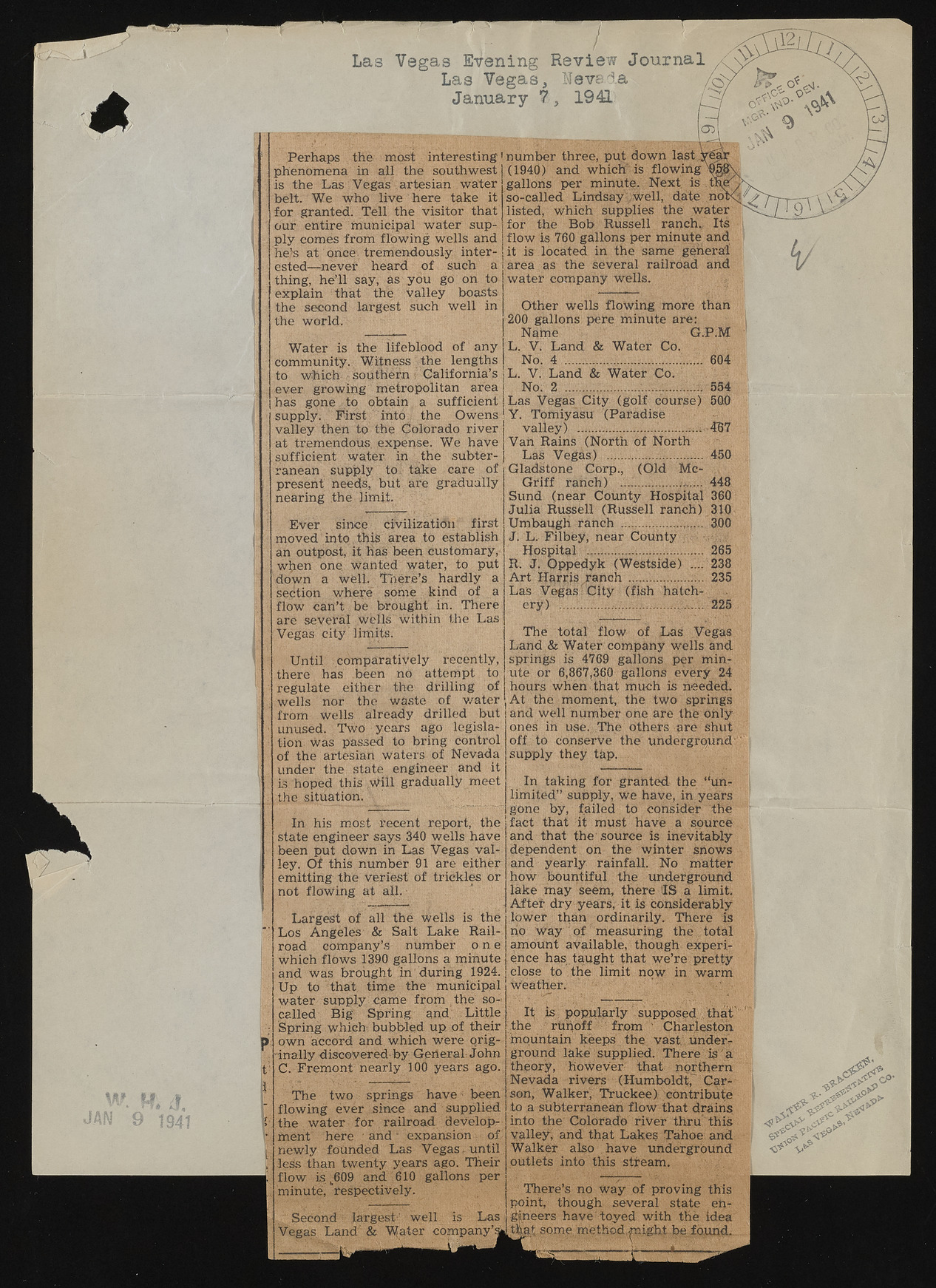Copyright & Fair-use Agreement
UNLV Special Collections provides copies of materials to facilitate private study, scholarship, or research. Material not in the public domain may be used according to fair use of copyrighted materials as defined by copyright law. Please cite us.
Please note that UNLV may not own the copyright to these materials and cannot provide permission to publish or distribute materials when UNLV is not the copyright holder. The user is solely responsible for determining the copyright status of materials and obtaining permission to use material from the copyright holder and for determining whether any permissions relating to any other rights are necessary for the intended use, and for obtaining all required permissions beyond that allowed by fair use.
Read more about our reproduction and use policy.
I agree.Information
Digital ID
Permalink
Details
More Info
Rights
Digital Provenance
Publisher
Transcription
Las Vegas Evening Las Vegas, ReNveviaelwa Journal January 7 , 1941 Perhaps the most interesting' phenomena in all the southwest is the Las Vegas artesian water belt. We who live here take it for granted. Tell the visitor that our entire municipal water supply comes from flowing wells and he?s at once tremendously interested— never heard of such a thing, he’ll say, as you go on to explain that the valley boasts the second largest such well in the world. Water is the lifeblood of any community. Witness the lengths to which 1 southern 51 California’s ever growing metropolitan area has gone to obtain a sufficient supply. First into the Owens valley then to the Colorado river at tremendous, expense. We have sufficient Water in the subterranean supply to. take care of present needs," but are gradually nearing the limit. Ever since civilization first moved into . this area to establish an outpost, it lias been customary, when one. Wanted; water, to put down a well. There’s hardly a section where some kind of a flow can’t be brought in. There are several wells' within the Las Vegas city limits. Until, .comparatively recently, there has been no attempt to regulate either the drilling of wells nor the waste of water from Wells already drilled but unused. Two years ago legislation Was passed to bring control of the artesian waters of Nevada under the state engineer and it is hoped this will gradually meet the situation. In his most recent report, the state engineer says 340 wells have been put down in Las Vegas valley. Of this number 91 are either emitting the Veriest of trickles or not flowing at all. Largest of all the Wells is the Los Angeles & Salt Lake Railroad company’s number o n e which flows 1390 gallons a minute and was brought in during 1924. Up to that time the municipal water supply came from the so- Called Big Spring and; Little Spring which, bubbled up of their own accord and. which Were Qrig-inally discovered* by General John C. Fremont nearly 100 years ago. The two springs have ? been flowing ever since and supplied the water for railroad development here and' expansion of newly founded Las Vegas, until leas than twenty years ago. Their flow is ,609 and1610 gallons per minute, respectively. Second | largest well is Las Vegas Land & Water company’* m m number three, put down last ife^r (1940) and which' is flowing " gallons per minute. Next is tk so-called Lindsay > well, date noK. listed, Which supplies the water for the Bob Russell ranch. Its flow is 760 gallons per minute and it is located in the same general area as the several railroad and water company wells. Other wells flowing more than 200 gallons pere minute are: Name G.P.M L. V. Land & Water Co. No. 4 ............................. 604 L. V. Land & Water Co. No; 2 .......... 554 Las Vegas City (golf course) 500 Y. Tomiyasu (Paradise valley) ...... .............467 Van Rains (North of North Las Vegas) ......................... 450 Gladstone Corp., (Old Mc- Griff ranch) ................. 448 Sund (near County Hospital 360 Julia Russell (Russell ranch) 310 Umbaugh ranch .................. 300 J, L. Filbey, near County Hospital _...... 265 R. J. Oppedyk (Westside) .... 238 Art flaFgis ..ranch ............. 235 Las Vegas City (fish hatch- . ery) ", 225 The total flow of Las Vegas Land & Water company wells and springs is 4769 gallons per minute: or 6,867,360 gallops every 24 hours when that much is heeded. At the moment, the two springs and well number one are the only ones in use. The others are shut off to conserve the underground supply they tap. In taking for granted the “unlimited” supply, we have, in years gone by, failed to consider the fact that it must have a source and that the'source is inevitably dependent on the winter snows and yearly rainfall. No matter how bountiful the underground lake may seem, there 'IS a limit. After dry years, it is considerably lower than ordinarily. There is no way of measuring the . total amount available, though experience has. taught that we’re pretty close to . the limit now in warm Weather, fi If is popularly supposed that .the V runoff from ' Charleston mountain keeps the vast;, underground lake supplied. There is a theory, however that northern Nevada rivers (Humboldt; Car-son, Walker', Truckee) contribute to a subterranean flow that drains into the' Colorado river thru this valley, and that Lakes Tahoe and Walker also have underground outlets into this stream. There’s no Way of proving this point,; though several state eh-gineers have' toyed with the idea that some method fnight be found.

